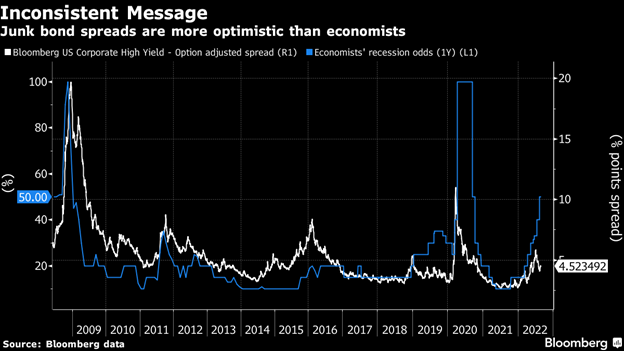Junk bond prices have collapsed, losing more than 15 percent of their value this year.
But the push to higher rates by central banks and the possibility of a deep recession point to a much deeper adjustment during 2023.
This will create some great opportunities for stock and bond investors.

This chart shows how junk bonds have performed over the last 15 years. The measure is the spread between government bonds and high yield bonds.
Junk bonds are also called high-yield bonds, but “high yield” doesn’t carry enough warning, so I prefer the name “junk”.
The risk in junk is probably greater than it has been for at least 12 years, if not longer. And great risk will bring wonderful opportunities, eventually.
The current yield spread on junk over safe assets is still too low — at about 4.5% — compared to the peak of past crises when a 10% spread over government bonds signaled an attractive balance between risk and reward.
At the current spread the junk bond market is too optimistic.
Were there some opportunities during past recessions in the junk bond market?
At the end of the Global Financial Crisis in spring 2009 the junk bond market opened its arms to companies that were on the brink of default, as investors were willing to take on more risk.
For example, a Canadian resource company called Teck was struggling in early 2009 after acquiring expensive metallurgical coal assets. Teck’s stock price plunged below $3 in early 2009 and by December 2010 the price touched $61.83, an all-time high.
How risky was Teck when the junk bond market came to its rescue?
In the summer of 2008 Teck made a poorly timed purchase of a key asset, 60 percent of the Fording Coal/Elk Valley Coal Partnership for US$10 billion. Assets at 2008 year-end were US$27 billion. Debt totaled about $12 billion and net earnings for 2008 were about $700 million.
At 10% interest the total debt would cost about $1.2 billion, substantially higher than net earnings. So, Teck was on the brink of default if they could not find lenders to fund billions of debts. Issuing enough shares to replace the debt was not an attractive option with the share price below $5.
And, at year-end 2008, there was a worldwide credit crisis, due to the collapse of Lehman Brothers in September and the turmoil in markets.
But by May 2009 the junk bond market had re-opened and Teck was issued 5,7- and 10-year notes for US$4 billion at rates between 9.75% and 10.75%.
The company also sold US$1.5 billion in shares to a Chinese investment entity.
Net debt at the end of 2009 declined to US$5.4 billion, less than ½ of the 2008 amount. Net earnings in 2009 rebounded to $1.8 billion. The crisis had passed but not before shares hit a new low of US$2.61.
An iconic Canadian company survived, but only with substantial help from the junk bond market at just the right time.
Hilliard MacBeth
The opinions expressed in this report are the opinions of the author and readers should not assume they reflect the opinions or recommendations of Richardson Wealth or its affiliates. Assumptions, opinions and estimates constitute the author's judgment as of the date of this material and are subject to change without notice. We do not warrant the completeness or accuracy of this material, and it should not be relied upon as such. Before acting on any recommendation, you should consider whether it is suitable for your particular circumstances and, if necessary, seek professional advice. Past performance is not indicative of future results. The comments contained herein are general in nature and are not intended to be, nor should be construed to be, legal or tax advice to any particular individual. Accordingly, individuals should consult their own legal or tax advisors for advice with respect to the tax consequences to them, having regard to their own particular circumstances.. Richardson Wealth is a member of Canadian Investor Protection Fund. Richardson Wealth is a trademark by its respective owners used under license by Richardson Wealth.